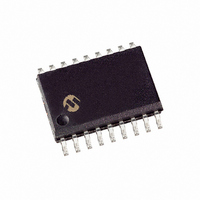PIC16C54B-04I/SO Microchip Technology, PIC16C54B-04I/SO Datasheet - Page 29

PIC16C54B-04I/SO
Manufacturer Part Number
PIC16C54B-04I/SO
Description
MICRO CTRL 512 4MHZ OTP 18SOIC
Manufacturer
Microchip Technology
Series
PIC® 16Cr
Specifications of PIC16C54B-04I/SO
Core Processor
PIC
Core Size
8-Bit
Speed
4MHz
Peripherals
POR, WDT
Number Of I /o
12
Program Memory Size
768B (512 x 12)
Program Memory Type
OTP
Ram Size
25 x 8
Voltage - Supply (vcc/vdd)
3 V ~ 5.5 V
Oscillator Type
External
Operating Temperature
-40°C ~ 85°C
Package / Case
18-SOIC (7.5mm Width)
Lead Free Status / RoHS Status
Request inventory verification / Request inventory verification
Eeprom Size
-
Data Converters
-
Connectivity
-
- Current page: 29 of 218
- Download datasheet (2Mb)
6.1
When an external clock input is used for Timer0, it
must meet certain requirements. The external clock
requirement is due to internal phase clock (T
synchronization. Also, there is a delay in the actual
incrementing of Timer0 after synchronization.
6.1.1
When no prescaler is used, the external clock input is
the same as the prescaler output. The synchronization
of
accomplished by sampling the prescaler output on the
Q2 and Q4 cycles of the internal phase clocks
(Figure 6-5). Therefore, it is necessary for T0CKI to be
high for at least 2T
and low for at least 2T
20 ns). Refer to the electrical specification of the
desired device.
FIGURE 6-5:
1998 Microchip Technology Inc.
T0CKI
Note 1:
Using Timer0 with an External Clock
EXTERNAL CLOCK SYNCHRONIZATION
2:
3:
External Clock/Prescaler
Output After Sampling
Increment Timer0 (Q4)
with
Delay from clock input change to Timer0 increment is 3Tosc to 7Tosc. (Duration of Q = Tosc).
Therefore, the error in measuring the interval between two edges on Timer0 input =
External clock if no prescaler selected, Prescaler output otherwise.
The arrows indicate the points in time where sampling occurs.
Prescaler Output (2)
External Clock Input or
TIMER0 TIMING WITH EXTERNAL CLOCK
OSC
the
(and a small RC delay of 20 ns)
OSC
internal
(and a small RC delay of
Timer0
phase
(3)
Q1 Q2 Q3 Q4 Q1 Q2 Q3 Q4 Q1 Q2 Q3 Q4 Q1 Q2 Q3 Q4
clocks
(1)
OSC
Preliminary
is
)
T0
When a prescaler is used, the external clock input is
divided by the asynchronous ripple counter-type
prescaler so that the prescaler output is symmetrical.
For the external clock to meet the sampling
requirement, the ripple counter must be taken into
account. Therefore, it is necessary for T0CKI to have a
period of at least 4T
40 ns) divided by the prescaler value. The only
requirement on T0CKI high and low time is that they
do not violate the minimum pulse width requirement of
10 ns. Refer to parameters 40, 41 and 42 in the
electrical specification of the desired device.
6.1.2
Since the prescaler output is synchronized with the
internal clocks, there is a small delay from the time the
external clock edge occurs to the time the Timer0
module is actually incremented. Figure 6-5 shows the
delay from the external clock edge to the timer
incrementing.
TIMER0 INCREMENT DELAY
T0 + 1
OSC
4Tosc max.
(and a small RC delay of
PIC16C5X
T0 + 2
Small pulse
misses sampling
DS30453B-page 29
Related parts for PIC16C54B-04I/SO
Image
Part Number
Description
Manufacturer
Datasheet
Request
R

Part Number:
Description:
MICRO CTRL 512 4MHZ OTP 18DIP
Manufacturer:
Microchip Technology
Datasheet:

Part Number:
Description:
MICRO CTRL 512 4MHZ OTP 18SOIC
Manufacturer:
Microchip Technology
Datasheet:

Part Number:
Description:
MICRO CTRL 512 20MHZ OTP 18SOIC
Manufacturer:
Microchip Technology
Datasheet:

Part Number:
Description:
MICRO CTRL 512 X 12 EPROM 18CDIP
Manufacturer:
Microchip Technology
Datasheet:

Part Number:
Description:
MICRO CTRL 512 4MHZ OTP 18DIP
Manufacturer:
Microchip Technology
Datasheet:

Part Number:
Description:
MICRO CTRL 512 4MHZ OTP 20SSOP
Manufacturer:
Microchip Technology
Datasheet:

Part Number:
Description:
MICRO CTRL 512 4MHZ OTP 20SSOP
Manufacturer:
Microchip Technology
Datasheet:

Part Number:
Description:
MICRO CTRL 512 20MHZ OTP 18DIP
Manufacturer:
Microchip Technology
Datasheet:

Part Number:
Description:
MICRO CTRL 512 20MHZ OTP 18SOIC
Manufacturer:
Microchip Technology
Datasheet:

Part Number:
Description:
MICRO CTRL 512 20MHZ OTP 20SSOP
Manufacturer:
Microchip Technology
Datasheet:

Part Number:
Description:
MICRO CTRL 512 20MHZ OTP 18DIP
Manufacturer:
Microchip Technology
Datasheet:

Part Number:
Description:
MICRO CTRL 512 20MHZ OTP 20SSOP
Manufacturer:
Microchip Technology
Datasheet:

Part Number:
Description:
Manufacturer:
Microchip Technology Inc.
Datasheet:










